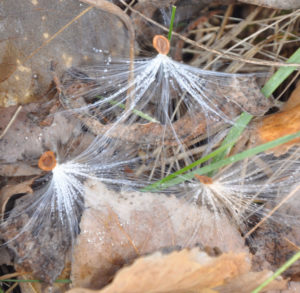
Covered with dew, the wind-driven seeds of milkweed rest in a nest of dried leaves. Dew is made of liquid water that has condensed from some of the water vapor in the air. (Photo credit: La Crosse Tribune archives)
Recent spring mornings have produced wet lawns. To explain this, we start with the fact that air contains water in the gas phase, called water vapor. Dew is made of liquid water that has condensed from some of the water vapor in the air.
Dew occurs when objects cool. A common example of dew formation is when drops of liquid form on the glass of an ice-cold drink. Dew forms when the object, such as the glass, cools down to the dew point temperature.
Water molecules in the air continually bombard surfaces, like blades of grass. Some of the molecules stick, forming a very thin film of water. This film may not last long, as the water evaporates. The evaporation rate depends on the temperature of the water, which is the same temperature as the blades of grass.
So, condensation depends on the state of the atmosphere, such as its temperature and moisture, while evaporation depends on the temperature of the object.
If the object gets cold enough, and there is enough moisture in the air, condensation is much greater than evaporation and the film grows into dew drops.
Each night the weather report includes the temperature and the dew point temperature.
If the two temperatures are close, it is likely that dew will form during the night.
Dew also tends to form on calm nights that come with clear skies. Windy conditions and cloudy skies keep the ground from cooling.

